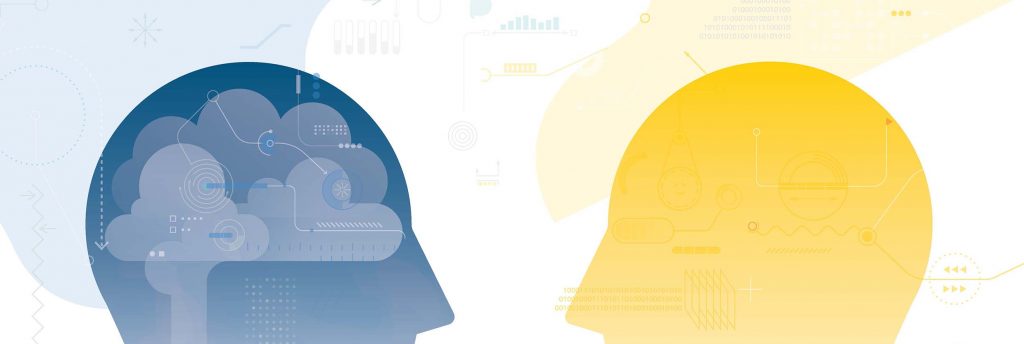Discovery. Innovation. Collaboration. Excellence. At CA, these aren’t just mission buzzwords; they reflect our community’s core values, and our faculty and students’ approach to learning. While examples across campus abound, one needs to look no further than the Upper School’s independent study program to see just how our mission comes to life in students’ hands.
Investigating the finer points of a scientific theorem. Filling gaps in research by tackling a question that historians haven’t yet investigated. Helping to address intractable issues in the local community. Honing an artistic technique. Exploring a new (world or programming) language. At the helm of independent projects and studies, countless Upper School students have done just that and more—to resounding success both personal and public.
Born of student ideation and facilitated by CA’s faculty, interest-driven independent studies and projects grant students the freedom and flexibility to truly own their learning. Limited only by their own curiosity, students design their own semester or year-long learning opportunities outside of the traditional curriculum, collaborating with faculty advisors to fine-tune a rigorous scope of work and set deliverables, timelines, and benchmarks for progress and success. Throughout, faculty advisors serve as seasoned guides, asking questions, sharing resources, and offering valuable feedback.
It’s a close collaboration that is rewarding for faculty and students alike, according to Upper School art teacher Karen Rose, who advises several students engaged in painting and ceramics independent studies. “Students get a taste of what it is to be an artist in the real world, self-directed and motivated. As an advisor, I have a community of artists that inspire me and who are constantly producing wonderful artwork in my room.”
Whether engaging in a deep dive inspired by classroom interests, experimenting with career possibilities, or exploring personal passions entirely outside of CA’s established curriculum, students have the latitude to take risks, experiment, and collaborate free from the pressure of a traditional grade book. (Independent studies for credit are pass/ fail; not-for-credit projects are ungraded).
“Independent studies offer all the things a good class does but are completely curated for an individual student’s interest and capabilities,” offers Upper School history teacher Naomi Barlaz. “I can meet students exactly where they are without having to worry about them comparing themselves to others. There are no stakes beyond learning for learning’s sake; it is purely about their interests, their skills, and their research. The things that can sometimes get in the way of learning don’t get in the way with these projects.”
The takeaways, both academic and otherwise, can be immeasurable. Responsible for the creation and execution of their projects, students lean into higher-level executive functions, practicing crucial project, communication, and time management skills. Empowered to chart their own course, they develop heightened confidence and even a more defined sense of identity, discovering who they are as people in the world, and what they may (or may not) want to pursue in the future.
For faculty, independent studies and projects offer welcome opportunities to continue to push the curriculum by piloting new concepts, allowing time to gather student buy-in and establish expectations for future outcomes. What may start as a select group of passionate students one semester, could spur programmatic innovation for the Upper School curriculum for years to come.
Read on to learn how four Chargers opted to use independent studies last year to explore their interests, family histories, and identities, with lasting impacts on themselves and the CA community.
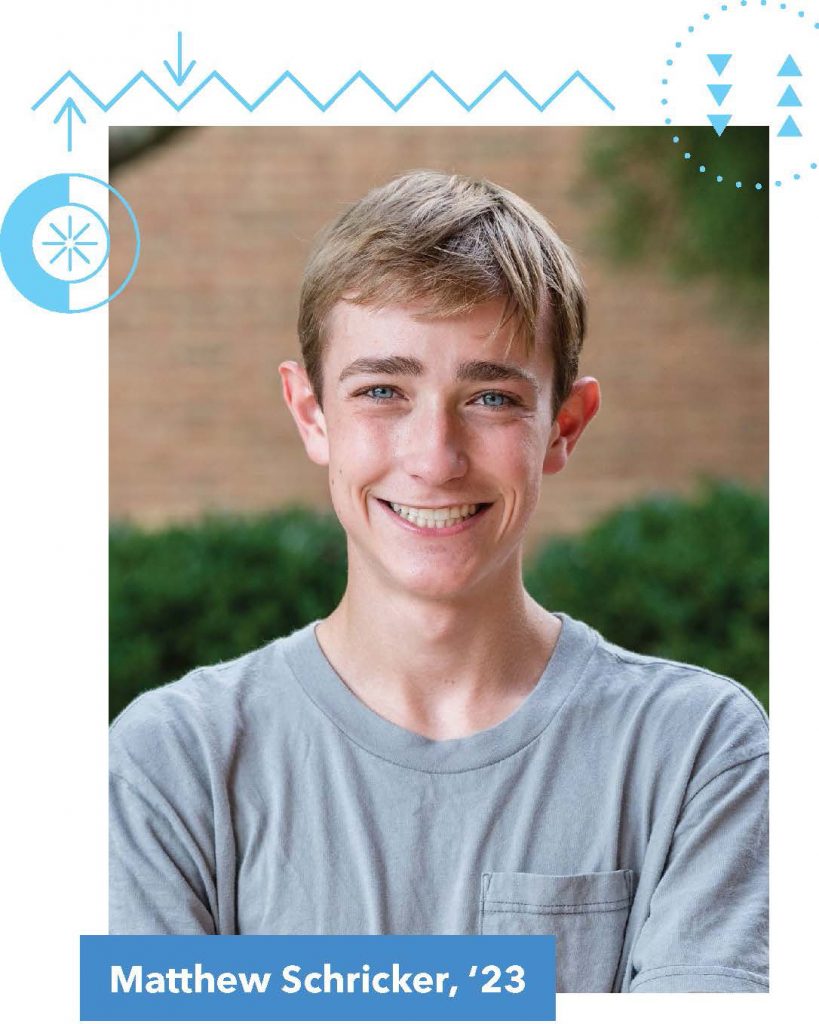
Shooting for the Future
This spring—just two hours before prom and over Zoom(!)—CA’s first-ever rocketry team brought home top prize and $3,500 in winnings from the American Rocketry Challenge’s 2022 Presentation Competition. For team member Matthew Schricker, ‘23, the win represents an impressive capstone to two back-to-back independent studies that have put him on the path to a career in aeronautic engineering.
Last fall, as a junior, Schricker devised his first independent study: an introduction to MATLAB, an engineering programming language used by millions of engineers and scientists to analyze data, develop algorithms, and create models. He had been instantly intrigued after learning about the language in his earlier AP computer science course.
“I intend to go into engineering or computer science,” offers Schricker. “Since so many colleges use MATLAB, I wanted to get an introductory understanding of it—to dip my toes in the water—beforehand.”
Rather than a dip, Schricker jumped in, embarking on two online courses with Mathworks, the maker of MATLAB. With support from Upper School advanced computer science teacher John Noland, he completed various coding projects, modeling everything from thermostats to Peregrine falcon flight trajectories.
Meanwhile, his new rocketry team, with sights set on the national competition, occupied his after-school and club time hours. The competition presented teams with a daunting task: design a rocket that could hit a prescribed altitude at a specific time while carrying a cargo of eggs.
“We had to devise a way to measure the rocket’s drag coefficient, the rate at which the air slows it. That determines when and how long to deploy the retractable fins that control its speed and altitude,” explains Schricker.
“It is a complicated thing to confirm drag coefficient. It typically requires a wind tunnel, which Cary Academy doesn’t have, and it can cost thousands to use one at a laboratory. While I was able to use my new MATLAB skills to model some rockets and run simulations, nothing beats the real thing.”
Intrigued by the problem and with a growing interest in aerodynamics, Schricker set out to learn more, embarking on a second independent study with guidance from Upper School physics teacher Dr. Matt Greenwolfe. This time, he pored over physics textbooks and instructional videos, discovering more about turbulent and laminar air flows and how to measure them and their effects on objects. With his final project, he devised the solution his rocketry team needed, designing and constructing a table-sized wind tunnel that CA student-scientists can use for years to come.
“My independent studies allowed me to pursue interests that were more niche than what was offered in the regular curriculum. To have that freedom, to put what I learned into successful practice for my rocketry competition, to be able to build something for CA—that’s just been really fun.”
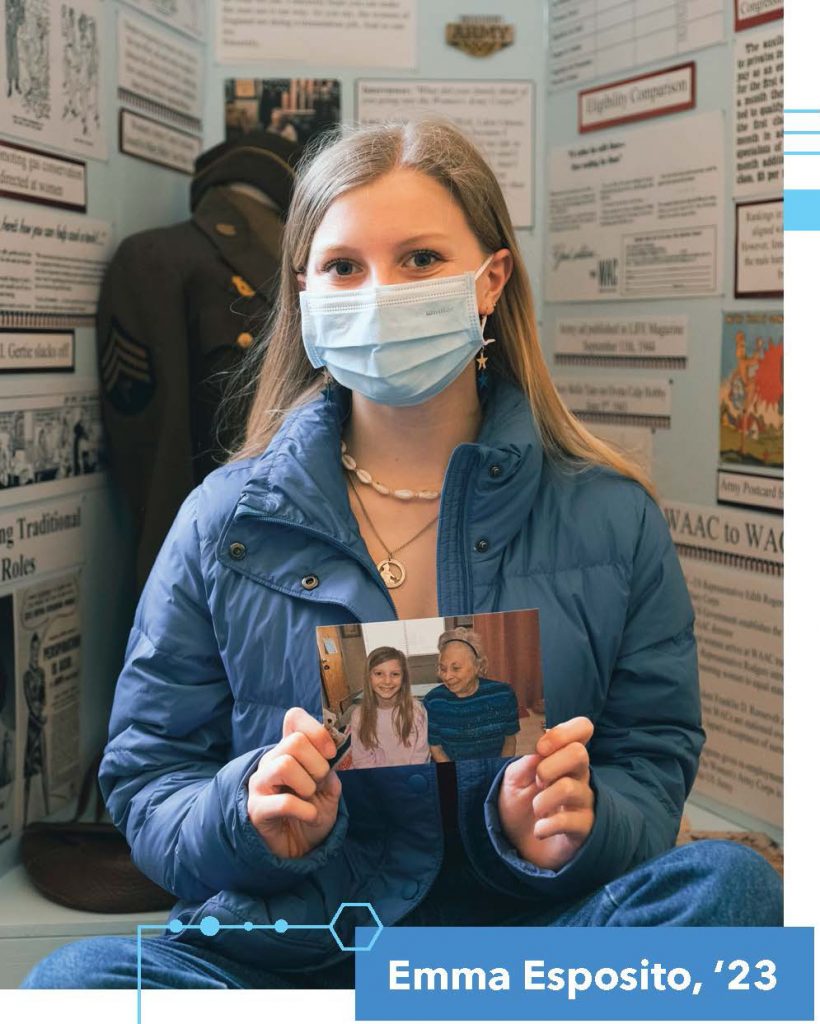
Personal History
Last year, Emma Esposito ‘23 discovered a treasure trove of family artifacts after the passing of her great- great-aunt Mary Belle Tate just shy of her 101st birthday. A member of the Women’s Army Corps during World War II, Mary Belle had documented her experience in hundreds of letters, photos, and postcards.
Perhaps to anyone, these would have been important family heirlooms. But to history buff Esposito, they represented a wealth of primary sources and historical artifacts that shed unique light on World War II. Inspired, she embarked on a year-long independent history project— an entry into the National History Day Contest—that would ultimately take her from Cary Academy to the Smithsonian.
The National History Day Contest is an annual, national contest that engages more than half a million students
in conducting original research on historical topics. Recognizing the rich opportunity Mary Belle’s legacy afforded her, Esposito opted to design a physical exhibit—the kind you might find in a history museum.
With Upper School history teacher Naomi Barlaz as her guide, Esposito threw herself into her research, which quickly grew beyond her personal connection Emma Esposito, ‘23 to encompass a larger investigation of women’s roles in World War II. Her finished project, a large three-sided construction standing six feet tall, represents the three-sided debate that emerged between the media (espousing prevalent gender norms), the military (which needed women’s labor), and Women Army Corps members themselves (who leveraged their WAC involvement as a stepping stone to equality).
“Coming into this project, I had a surface-level understanding of the Women’s Army Corp and of World War II,” offers Esposito. “But to have the freedom and flexibility to go to this depth, to be able to use primary sources to analyze different perspectives of what people thought at the time—I learned far more than I could have in a regular classroom setting.”
Assuming the role of a working historian, Esposito refined her research skills—discovering how to corroborate, approach, and cite primary sources. She learned how to recognize her own bias and to conduct impartial historical analysis. “I learned not just to form my own opinion, but to ask: ‘Where is this coming from? Who wrote this? What are they thinking?’ and to present it impartially.”
A visual artist, Esposito relished the design dimension of the project. She partnered with CA arts faculty and the Center for Community Engagement— which helped fund her project—to bring her project to life. Performing Arts Director Michael Hayes and Technical Director Aaron Yontz helped her think through fabrication and materials, instructing her on the ins and outs of construction and working with power tools. Upper School art teacher Karen Rose provided a crash course in color theory, helping her select paint colors that made her artifacts visually pop. Video Studio Manager Steven O’Neill helped her to create a video that represented her project.
“Everyone at CA was so supportive in the creation of my piece; everyone got so excited for me. It wasn’t just ‘do this part for me,’ it was working together to reach what was right for my project. It was so exciting to be directing every aspect, even when I didn’t know how to do it—they all patiently mentored me and helped me bring my vision to fruition.”
Esposito’s hard work paid off. Her project—Beyond Backing the Attack: WAC Participation in WWII—took first place in the senior individual exhibit category for high school students at both regionals and states, earning her a place in the national competition. Her project was also selected by the Smithsonian’s National Museum of American History and the Smithsonian Learning Lab as one of 51 exhibits that will be featured in the Smithsonian’s National History Day 2022 Virtual Showcase.
“Having these ties, these primary sources has been so motivating to me,” offers Esposito, whose quick to thank her grandfather for carefully preserving Mary Belle’s artifacts these many years. “I never really had the chance to understand Mary Belle while she was living. But looking back through the lens of my research question and thesis, I can understand her now.”
“This project was never for a grade. It has always been purely a passion project,” she continues. “I’ve learned a lot about myself in the process—about what I want to do with my future. I know that I won’t always have these personal ties to a project, but it shows me that my academic interests and personal passions can align—and that’s exciting.”
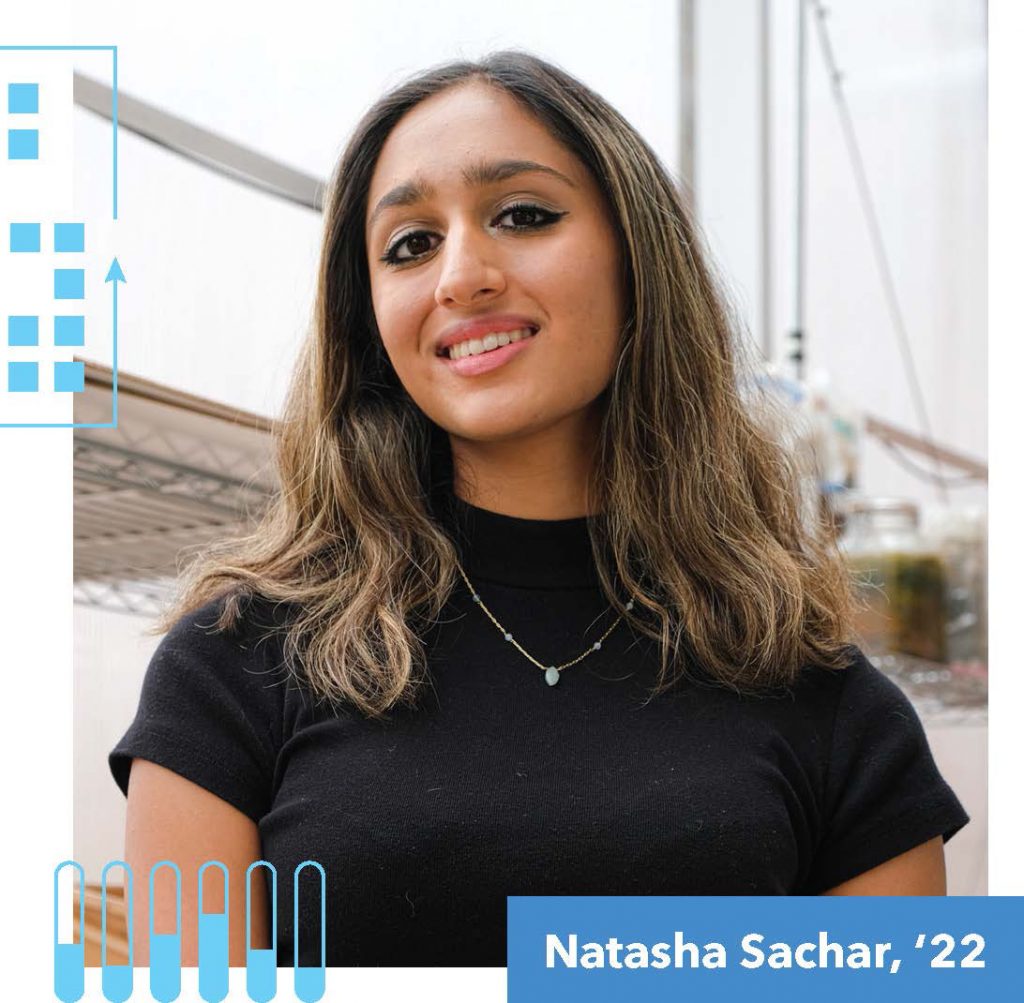
Pursuing Passion with Purpose
This fall, when passionate climate activist Natasha Sachar, ’22, arrives at the University of California, Berkeley, to study environmental policy, she’ll be no stranger to the challenging work of climate scientists. Thanks to a multi-year, cross-class independent study, she has plenty of hands-on experience in emissions research, data modeling, and analysis—and in working towards tangible change on CA’s campus.
As a senior, Sachar jumped at the chance to continue an independent study originated by upper-level student and friend, Armita Jamshidi, ’21, aimed at calculating and reducing Cary Academy’s ecological footprint.
“As we move forward to combat climate change, institutions, especially high school institutions like Cary Academy, need to follow the path that many college institutions are taking towards carbon neutrality, towards a neutral or even negative carbon footprint,” offers Sachar.
Jamshidi’s original project defined three distinct scopes, each representing a different stage in a comprehensive carbon audit for CA and culminating in a five-year plan to move CA towards carbon neutrality. With the completion of scope one in 2021—calculating the emissions generated on CA’s campus—Sachar picked up the collaborative study for scope two: determining the carbon footprint associated with CA’s energy consumption.
Sachar found it no small task and certainly not a straightforward one.
“Much of my project was investigative,” explains Sachar, “I had to figure out how I was going to calculate scope two—what data to use, where to get the numbers from, what predictive models to use, and how to leverage them to calculate CA’s energy use.”
Guided by Upper School science teacher Heidi Maloy, Sachar conducted an extensive review of published studies from other institutions working towards carbon neutrality. She researched and assessed various predictive data models and calculators to determine which might be the best fit for her project’s—and CA’s—needs. Once identified, she pored over months of data from CA’s Duke Energy and Dominion Energy statements, calculating and analyzing campus energy use and extrapolating a curve of CA’s predicted energy use for the future.
Sachar also laid the requisite groundwork for the start of scope three, analyzing and identifying the data sources and models that will be used to calculate CA’s “excess emissions,” those associated with the goods and services that CA uses. “Scope three is interesting and enormous; it encompasses everything from the emissions from faculty and student commutes to the electricity our servers use to the waste we generate, and everything in between. It is important for pinpointing where in the supply chain, and our institutional consumption, we have targetable hotspots for emissions,” offers Sachar.
For Sachar, her independent study was an experience for which she is grateful.
“In class, I was learning about all these macro examples and about carbon emissions in other places; the opportunity to focus on our community was exciting. I am grateful that CA has so many opportunities for students to do that—to make actual change in our community and on our campus.”
Next year, Sachar’s work will be taken up by a new group of scholars who will continue the work of moving CA towards carbon neutrality.
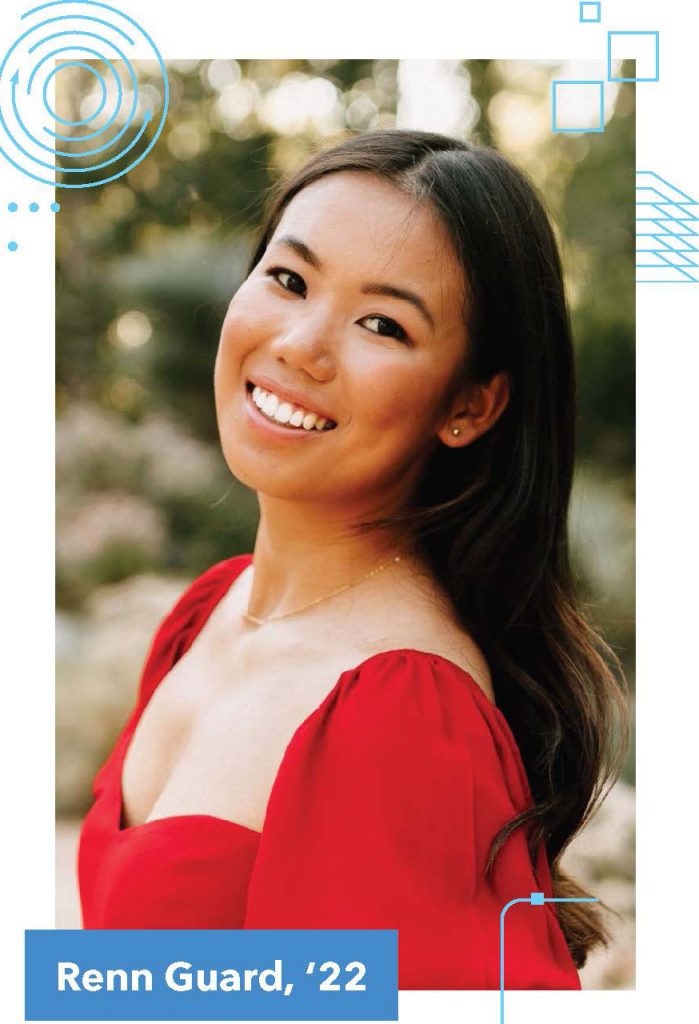
Finding Herself
This fall, recent grad Renn Guard, ’22, will be headed to Seoul, South Korea, to study Korean language and culture after being awarded the prestigious 2022-23 National Security Language Initiative for Youth scholarship by the U.S. Department of State. The rigorous program—designed to foster international cooperation by ensuring that Americans have the linguistic skills and cultural knowledge necessary to communicate effectively—marks another stop on a journey of self-discovery.
“I’ve always been interested in international studies, specifically East Asian studies,” explains Guard. “Throughout my high school career, I looked for ways to incorporate those interests in my learning.” She found the flexibility to do so in CA’s student-led, interest-driven approach to learning, which allowed her the freedom to chart her own course for her studies.
As a junior, Guard worked with the Upper School administration in the fall to develop an independent study to learn Korean, an emerging interest, through an online program with Hills Learning, a New York City center focused on Asian languages. The previous spring, COVID-19 had begun to take hold across the world, spurring a new wave of racist, anti-Asian sentiment. Increasingly, Guard, who is adopted and has Chinese heritage, found herself grappling with new questions about her identity.
“With everything that was happening in the world and in the country during COVID, I was forced to reflect further on how my Asian identity affected my beliefs and place in the world. I had a lot of questions that I was very invested in trying to answer for myself.”
With support from her CA teachers, Guard paired her personal quest with her academic interests. As a junior, she applied and was accepted to Stanford University’s highly competitive Sejong Korea Scholars Program. Led by top scholars and experts in the field, the collegiate-level online program offered Guard the chance to delve deep into Korean history and U.S.-Korea relations. It was an illuminating experience that deepened her interest in international studies while simultaneously raising additional—and more personal—questions.
“All of the students had different backgrounds that shaped our opinions and perspectives,” explains Guard. “We were constantly reflecting on what that meant, about what it means to study a culture, particularly one that is not your own.” Inspired to learn more about her own heritage, as a senior, she once again applied to and was accepted into Stanford’s Chinese Scholars Program. For Guard,
it was a deeply satisfying exploration of the forces shaping modern China and its relationship with the United States.
“We explored Chinese exclusion, Chinese infrastructure, Chinese adoption, Chinese economic development and trade, the Chinese diaspora. I was working with students who were Chinese, some who were first-generation Americans, some who were second, and some who were adoptees. The course was another opportunity to exercise ownership and Renn Guard, ‘22 curiosity in my identity with academically and personally invested peers. Now, I have even more tools to talk academically about East Asia and reclaim part of my history at a deeper level.”
After Guard completes her year in Seoul, she will attend the University of North Carolina at Chapel Hill where she plans to continue her international studies. Happily, she has been accepted into the Carolina Global Launch program and will spend her first semester at Maynooth University in Ireland.
Guard appreciates the support and flexibility granted to her by CA and credits her independent project work— all of which required in-depth research and critical thinking skills, as well as the development of exceptional time management and communication skills—with preparing her well for whatever comes next and for giving her the confidence to continue to follow her passions.
“These experiences gave me the skills I’ll need in college. I’m confident; I can say ‘Oh, I’ve got this. I’ve done this before.’”

